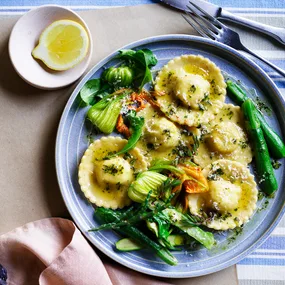Broccoli gets a bad rap. The childhood dislike for this vegetable is probably due to it often being rendered almost tasteless by overcooking. But recent publicity of the benefits of cooking green vegetables briefly has helped improve broccoli’s reputation, with it arriving at the table tender and tasty.
Broccoli was first mentioned in print by ancient Roman cookbook author Apicius. In Italian, the word translates to ‘little arms’ or ‘little branches’ and the vegetable’s origin is made clear with the most common variety’s name: Calabrese (after the southern Italian region).
In Italy today, broccoli is still a favourite, prepared in various ways: puréed, stewed with olive oil, garlic and chilli, baked with butter and parmesan, blanched for salads and cooked for pasta sauce. In Lombardy, florets are dipped in egg, cheese and breadcrumbs and fried in butter to create broccoli Milanese.
Broccoli is a Brassica oleracea, related to cabbage and cauliflower. There are several varieties and some hybrids in the broccoli family. Calabrese is the most readily available green sprouting variety, found in greengrocers and supermarkets everywhere. It’s available all year, with the peak season from May to September.
There is also a purple sprouting variety, not so readily available, which turns green on cooking. Gai lan, also known as Chinese broccoli or Chinese kale, has long stems and leaves and, often, yellow flowers. Broccolini, a hybrid of broccoli and gai lan, has long stems similar to gai lan, with small heads of tight flowers like broccoli. Broccolini was introduced to Australia in 1999 and is trademarked to Perfection Fresh. Broccoflower, a cross between broccoli and cauliflower, is bright yellow-green and may be substituted for either when being cooked; it’s available from April to September. Broccoli Romanesco is a lime-green vegetable similar to that of the broccoflower and is made up of tight pyramid-shaped clusters of flowers. It’s available later in the year. Broccoli rabe, despite its name, isn’t actually broccoli but a member of the turnip family.
Choose broccoli, broccoflower and Romanesco that have compact flower buds, firm stems and no signs of yellowing. Avoid any strong-smelling broccoli. Store in a plastic bag in the crisper section of the fridge for up to a week.
When buying gai lan and broccolini select those with bright-green and unblemished leaves and firm stalks. Store in crisper for up to three days.
The whole vegetable may be eaten. For broccoli and broccoflower, trim tough stalks, peel tough outer skin and cut into florets. For broccolini and gai lan, keep whole or cut into lengths, then steam, stir-fry, boil or deep-fry until tender, and purée for soups and sauces. Broccoli and broccolini may be eaten raw or blanched for salads.
*For broccoli pasta, heat butter and anchovy fillets in a saucepan over medium heat until anchovies start to dissolve. Add thinly sliced golden shallot, chilli and garlic and cook for 5 minutes or until tender. Add broccoli florets and enough chicken stock to just cover. Cook for 15 minutes or until broccoli has almost disintegrated and liquid reduced, stir through cream and finely grated lemon rind, and season to taste with sea salt and ground black pepper. Toss sauce through cooked fettuccine and serve scattered with toasted pine nuts and grated Manchego.
*For gai lan stir-fry, heat vegetable oil in a wok over high heat, add thinly sliced onion, ginger and garlic, then cook for 3 minutes or until tender. Add thinly sliced barbecued pork and cook for 3 minutes or until heated through. Add gai lan and thinly sliced long, red chillies and cook for 5 minutes or until tender. Add toasted cashews, drizzle with oyster sauce, toss through rice noodles and serve.
*For broccoflower gratin, cook broccoflower florets in boiling salted water for 5 minutes or until tender, then drain. Melt butter in a frying pan, cook finely chopped garlic until tender, add broccoli and thyme leaves, toss to combine, season to taste, then place in an ovenproof dish. Combine finely grated parmesan, Gruyère and crème fraîche. Season to taste, spoon over broccoli and scatter with breadcrumbs. Bake at 180C for 10 minutes or until golden.
*For broccoli and speck risotto heat olive oil in a frying pan, add thinly sliced golden shallot and speck cut into 1cm batons, sauté for 5 minutes until crisp add vialone nano rice and cook for 1 minute, then gradually add hot chicken stock ½ cup at time stirring after each addition and adding more when liquid has absorbed. Add broccoli cut into florets and cook for 3 minutes or until tender. Stir through grated lemon rind and pecorino, butter and season to taste.
Almonds, anchovies, bacon, butter, cheese, chicken, chilli, cream, eggs, garlic, ginger, ham, lemon, noodles, olive oil, olives, oyster sauce, pasta, pine nuts, rice, tuna, walnuts.
It’s not always easy being green, but smart cooking methods and nutritional guidelines have given broccoli a fresh spin.
Ingredients
Method
Main
Apples, cumquats, custard apples, grapefruits (yellow and ruby), lemons, limes, mandarins, nashi, oranges (blood and navel), pawpaw, pineapple, pomelos, rhubarb, tangelos.
Asian greens, avocados (fuerte, hass, sharwill), beetroot, Brussels sprouts, cabbage, carrots, cauliflower, celeriac, celery, fennel, garlic, ginger, horseradish, Jerusalem artichokes, kohlrabi, leek, okra, olives, onions, parsnips, potatoes, pumpkin, shallots, silverbeet, spinach, swede, sweet potatoes, turnips, witlof.
Australian salmon, black bream, blacktip shark, greenlip abalone, grey mackerel, ling, mirror dory, Murray cod, orange roughy, school prawns, school whiting, snapper, spanner crabs, tiger flathead, warehou, yellowfin whiting.
ALSO IN SEASON
Fruit
Vegetables
Seafood
Notes










